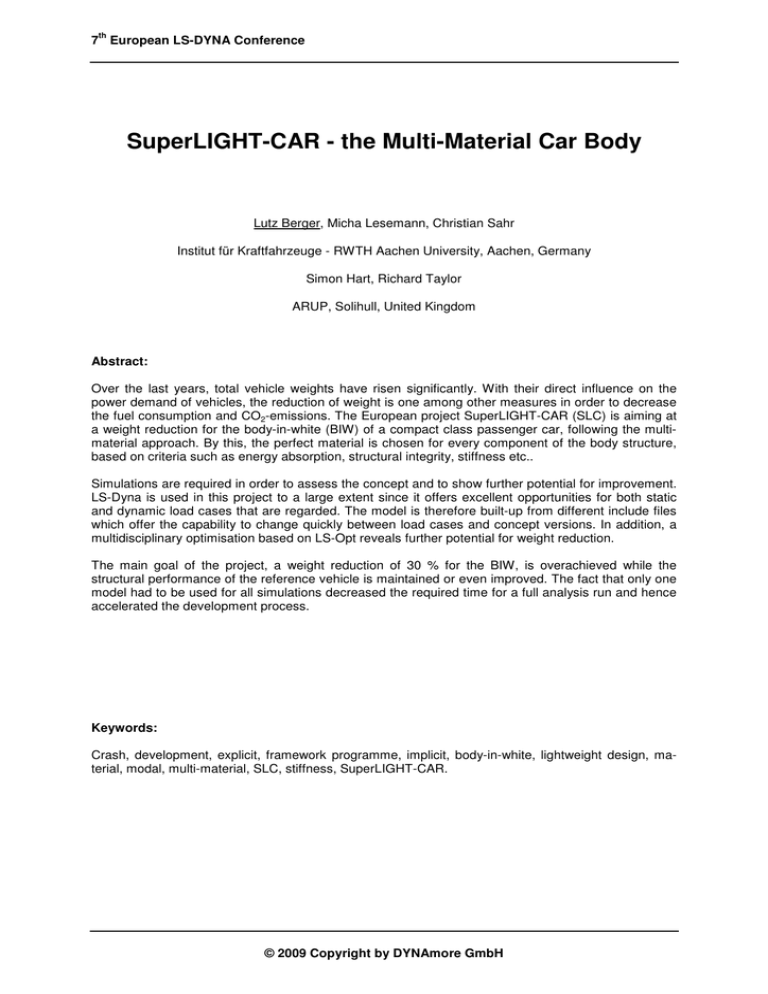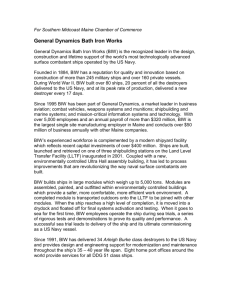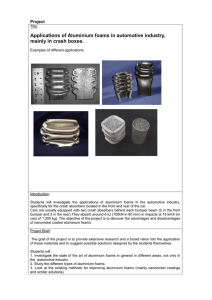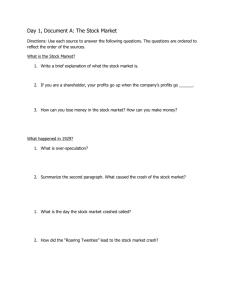SuperLIGHT-CAR - the Multi-Material Car Body
advertisement

th 7 European LS-DYNA Conference SuperLIGHT-CAR - the Multi-Material Car Body Lutz Berger, Micha Lesemann, Christian Sahr Institut für Kraftfahrzeuge - RWTH Aachen University, Aachen, Germany Simon Hart, Richard Taylor ARUP, Solihull, United Kingdom Abstract: Over the last years, total vehicle weights have risen significantly. With their direct influence on the power demand of vehicles, the reduction of weight is one among other measures in order to decrease the fuel consumption and CO2-emissions. The European project SuperLIGHT-CAR (SLC) is aiming at a weight reduction for the body-in-white (BIW) of a compact class passenger car, following the multimaterial approach. By this, the perfect material is chosen for every component of the body structure, based on criteria such as energy absorption, structural integrity, stiffness etc.. Simulations are required in order to assess the concept and to show further potential for improvement. LS-Dyna is used in this project to a large extent since it offers excellent opportunities for both static and dynamic load cases that are regarded. The model is therefore built-up from different include files which offer the capability to change quickly between load cases and concept versions. In addition, a multidisciplinary optimisation based on LS-Opt reveals further potential for weight reduction. The main goal of the project, a weight reduction of 30 % for the BIW, is overachieved while the structural performance of the reference vehicle is maintained or even improved. The fact that only one model had to be used for all simulations decreased the required time for a full analysis run and hence accelerated the development process. Keywords: Crash, development, explicit, framework programme, implicit, body-in-white, lightweight design, material, modal, multi-material, SLC, stiffness, SuperLIGHT-CAR. © 2009 Copyright by DYNAmore GmbH th 7 European LS-DYNA Conference 1 Introduction A considerable progress in automotive lightweight design was made by the implementation of new materials like high-strength steels and the partial use of aluminium as well as plastics in the past years. For an advanced weight reduction with the aim to reverse the trend of rising vehicle kerb weight and to achieve a more efficient contribution to fuel consumption reduction, a transition to new body structure design is needed. One key to super lightweight design could be the multi-material mix. In this process, the material for a special body part is used where it is needed in order to fulfil the requirements and to minimise the weight in parallel. Over the past four years, a lightweight multi-material body-in-white for high-volume car production was developed in the collaborative research and development project SuperLIGHTCAR. Besides seven European original equipment manufacturers (OEM) another 30 leading organisations are members of the consortium. 2 Reasons for Lightweight Design Demands on modern vehicles grow from generation to generation. This mainly concerns features like safety, comfort, driving performance, roominess, variability and quality. In general, these requirements are fulfilled by the use of heavy engines, improvement of the chassis, a higher stiffness in the BIW and more package parts. These implementations influence and enforce each other, so that the vehicle weight increased in the past years (Figure 1). Figure 1: Trend Total Vehicle Weight Lightweight design of the BIW compensates partially the gross weight of the vehicle. This also leads to an improvement of the lightweight quality (1). The lightweight quality is a measure to assess the quality of a body structure regarding the realisation of lightweight design. The weight of the BIW mGer is divided by its torsional stiffness c1 and the product of wheel track and wheel base A (equation 1). L= m Ger kg c 1 ⋅ A Nm / Grad ⋅ m 2 ⋅ 10 3 (1) Rising gross vehicle weight influences the power requirements directly and therewith the fuel consumption respective CO2-emission. See equation (2): © 2009 Copyright by DYNAmore GmbH th 7 European LS-DYNA Conference PBed = PBeschl + PSteig + PRoll + PLuft ( 2) = (ei ⋅ mF + mzu ) ⋅ a ⋅ v + (mF + mzu ) ⋅ g ⋅ sin(α Steig ) ⋅ v + (mF + mzu ) ⋅ g ⋅ fR ⋅ cos(α Steig ) ⋅ v + 1 2cw ⋅ A ⋅ ρL ⋅ v 3 Hence, lightweight design is a good technique to reduce fuel consumption and the CO2-emissions. A contribution to achieve the CO2 targets, which are decided by the European Union (EU) in December 2008, should be possible. Figure 2 pictures the current state of the regulation for new vehicles regarding CO2-emission starting with the ACEA negotiated agreement from 1995. According to this, the emissions of all new vehicles inside the EU shall be reduced to 130 g CO2/km until 2012. Actions such as higher use of bio fuels shall reduce the value to another 10 g CO2/km, but these actions are not further specified. There are penalties between 5 and 95 euro per gram CO2 and vehicle starting in 2012, if the values are not kept. CO2 emission [g/km] 200 185 g/km (1995) 100 177 g/km (2000) 95€/g 4 g/km 80 160 140 g/km (2008) 120 120 g/km 130 g/km (2015: 100 %) 60 120 g/km (2012: 65 %) 95 g/km (2020) 80 Actual CO2 fleet emissions in the EU 40 0 1995 Former planning according to ACEA self commitment Current planning (difference through other measures) 2005 25€/g 3 g/km 15€/g 2 g/km 20 5€/g 1 g/km Possible fines for exceeding CO2 limits 2000 40 2010 2015 0 2020 Fines for exceeding the CO2 limits [€/g CO2 / (km ⋅ Fzg)] 120 240 Figure 2: CO2 Emissions – Evolution in the EU For the development of a SuperLIGHT-CAR, a weight scenario was defined which is based on the ACEA negotiated agreement. Hereby the CO2-emission should be reduced by 20 g CO2/km. Half of this reduction should be achieved by weight reduction. Assuming that 0.3 l/100 km fuel are saved by saving 100 kg and a reduction of fuel consumption of 0.1 l/100 km equals to a CO2 reduction of 2.5 g/km, a weight of 130 kg results. While the weight of the BIW is high, it is not the only part of the gross weight since there are some non structural-relevant parts like doors and closures. These parts allow a reduction of approximately 45 kg by using plastics right away. Hence for the BIW, a reduction about 85 kg is aspired. This represents 30 % of the weight of a current mid-size car and is the aim of the SuperLIGHT-CAR project. 3 SuperLIGHT-CAR project In the collaborative research and development project SuperLIGHT-CAR, 37 partners from the automotive industry join in 2005 to develop a BIW for a mid-size car in multi-material design. Partners from European OEMs are VW, Fiat, Opel, Volvo, Daimler, Porsche and Renault. Further 30 leading research organisations are members of the consortium. The reference model is based on the Golf V. The primary aim is to save 85 kg of the BIW weight by using different materials. The lightweight costs, the quotient from additional costs in euro per saved kilogram, should not be higher than 5 euro. All requirements which exist nowadays for the BIW in mass vehicle production should be considered. This includes mainly economic restrictions and technical feasibility. Besides concept work, there were sub-projects which deal with material and production technologies. Lifecycle-analysis and cost evaluation of the product-life-cycle are carried out. Finally, there will be a prototype which realises the final concept in hardware. Figure 3 shows the subprojects and the time schedule of the project. © 2009 Copyright by DYNAmore GmbH th 7 European LS-DYNA Conference SP1 Concept Development Detailed SLC concept 1) Steel intensive < 2,5 €/kg 2) Multi-material mix, economical (ULBC) < 5 €/kg 3) Multi-material mix, weight optimized (SLBC) < 10 €/kg Preliminary SLC concepts SP2 Material and Production Technologies SP4 Technology screening Forming Joining Technology Production planning SP3 Assembly SLC BIW Prototype Analysis & Simulation Life Cycle Analysis (LCA) 2005 2006 Virtual and physical testing Cost evaluation 2007 2008 2009 Figure 3: Sub-projects and Timing There were three different concepts at the beginning with the main difference in the allowed lightweight cost. Finally, a combination of all concepts with the most promising results and realistic economic approach was chosen. The combination and optimisation was done in three loops. All loops include the load cases mentioned in chapter 5. 4 Engineering Approach There are different approaches for lightweight design. Constructive methods are used to generate optimal part geometry concerning weight. Manufacturing methods focus on new production technologies regarding material (e.g. Tailored Blanks or flexible rolling) and joining technique (e.g. adhesive joining or friction stir welding). Material lightweight design uses materials such as light metals or plastics. A combination of these methods is possible. This promises the best weight saving but it is very ambitious for the development process. 4.1 Engineering trends Different engineering trends evolve for the vehicle development process. Crash relevant parts can become lighter by using hot formed steel. Styling elements can be produced by using light materials like plastics. Also closures can, as mentioned before, force the light weight reduction idea if they are made out of plastics or light metal. Profile-intensive constructions are a good approach for structural parts. Existing solutions are built up in aluminium and steel. Present mass-produced solutions use aluminium for the front structure and steel for the rest of the BIW for a better axle load distribution. Furthermore, there are existing hybrid structures where aluminium and steel are used for different parts in the BIW widely. The current version of the Audi TT is a good example. A consequent evolution of all of these trends is the multi-material mix, which the SuperLIGHT-CAR project follows. 4.2 SuperLIGHT-CAR Approach The idea behind multi-material design is to choose the best material for each part of the BIW which fulfils the given requirements by minimal weight. This is the approach which the SuperLIGHT-CAR project sticks to in the development process. The process is split up in three phases (Figure 4). First, a topology optimisation was done to find the optimal load paths. Stiffness load cases and crash loads were defined. The latter ones were represented by static loads. In the beginning of the project, the package was defined as fix and remained unchanged. This is one reason why the topology proposal does not differ very much from the reference. © 2009 Copyright by DYNAmore GmbH th 7 European LS-DYNA Conference Additional boundaries + Joining + Costs + Manufacturing Steel Intensive Body Concept Super Light Body Concept Topology Optimisation Final SLC Concept Ultra Light Body Concept Figure 4: Concept Derivation of the SuperLIGHT-CAR Project The result of the topology optimisation is an optimal material distribution for the defined load cases. The interpretation and the realisation of this proposal remains classic engineering work. There are also more requirements which have to be considered in the construction phase. Especially in the field of multi-material design there are additional requirements regarding joining, costs and producibility. It is very difficult for the engineer to choose the most capable material, mainly when the material is not common in BIW application. Therefore, a methodology was developed in the SuperLIGHT-CAR project which supports the engineer in choosing the right material (see chapter 5.1). 5 Virtual Development The development of the SuperLIGHT-CAR is mainly done virtual. In the end of the project, a prototype will be built up in order to proof the feasibility of the concept. 5.1 Material Selection Methodology The choice of suitable materials can be very difficult for an engineer. Especially if materials are used for the first time in a BIW. For this reason, a methodology was developed in the SuperLIGHT-CAR project which supports the engineer in an early and important design phase to find the right material. For this purpose, the requirements for every part have to be identified and rated. The criteria are: - energy absorption structural integrity stiffness formability surface quality NVH The same criteria are used to rate the material properties. A comparison of these criteria gives the engineer an idea about a selection of possible materials. The next step is to involve additional criteria like: - costs life cycle analyse simulation corrosion joining © 2009 Copyright by DYNAmore GmbH th 7 European LS-DYNA Conference - producibility In the end of this process, a pre-selection of materials for certain parts results. This pre-selection has to be evaluated by experts and, if necessary, checked by simulations. As an example, the longitudinal member front is used for this process. The tool proposes a dual phase steel first. Because of the weight, the second proposal has to be selected. This is an extrusion profile made of aluminium. In this case, the joining of the surrounding parts is very complex, so the third material proposal, an aluminium sheet, is used. The methodology supports the material choice but the engineering expert knowledge cannot be replaced. 5.2 Simulation The design of the proposal is checked by simulation. Typically, this process is iterative. A couple of load cases were defined in the beginning of the project and the target of achieving at least the structural performance of the reference vehicle was set. The static load cases have shown by modal analysis the eigenfrequency of the BIW and the static torsion as well (Figure 5). The crash load cases include: - Euro NCAP front crash Euro NCAP side crash Euro NCAP pole crash FMVSS 301 rear crash FMVSS 216 static roof test AZT insurance classification test Furthermore, multidisciplinary optimisations were performed after every simulation loop. They help to reduce the sheet thickness of the parts to the necessary value. All static and dynamic runs were performed in LS-Dyna 971 R2. Due to the modular structure, consisting of multiple include files, both implicit and explicit runs could be done without any conversion. With the help of Oasys Primer the include structure of the model could be arranged very effectively. The package of the vehicle model was not changed during the project time and was tied to the last BIW version. The boundary conditions of the different load cases, like barriers and added mass, were split as well in different files. Figure 5: Torsional Stiffness of Final SuperLIGHT-CAR Concept The implicit analysis was run using SMP LS-Dyna 971 R2 in double precision. The run was solved incore requiring 3.7 Gigawords. The calculation time was 31 minutes on a Xeon 64bit system. The explicit runs were done in single precision in MPP. An Opteron cluster with 8 CPUs e.g. needs about 14 hours for the calculation of the pole crash. Depending on the load cases, the model consisted of about 1 million elements. The possibility to run static and dynamic loads with LS-Dyna can save significant time and accelerate the development process. © 2009 Copyright by DYNAmore GmbH th 7 European LS-DYNA Conference 6 Results SuperLIGHT-CAR concept The simulation results show that the performance of the SuperLIGHT-CAR concept is comparable to the reference, often even better. This can be rated as success of the development methodology. The biggest challenges were the choice of the material and the design appropriate for the material involved. The modal analysis shows a torsion mode at the rear starting at a frequency about 50 Hz. This surpasses the targets. The same result is obtained for the bending in the frontal longitudinal members that appears as required above 50 Hz. The torsional stiffness of 25.5 kNm/° is comparable to the reference and shows no discontinuity. A significant improvement is shown in the Euro NCAP front crash. The intrusion into the passenger compartment is below the limits for all measuring points. The deceleration comparable to the reference and the doors can be opened after the crash. There are 14 measuring points for the side crash. These are chosen in the area of the b-pillar and the doors. The Euro NCAP side crash barrier leads to no critical intrusion to the passenger compartment. The intrusion velocity of the b-pillar is the same as the one from the reference and fulfils the targets. Even the pole crash does not show any decline of the results. The drivers surviving space, measured in the area of the door, is good with 547 mm. The concept fulfils all defined needs in the rear crash according to FMVSS 301 and frontal AZT insurance classification test. The same result is given for the FMVSS 216 roof crush, which was explicitly calculated. The roof structure performs three times better than required and is able to fulfil future limits of this load case. The weight and material distribution of the final concept is shown in Figure 6. Aluminium is with 53 % the most used material. Besides aluminium sheet and cast aluminium also extrusion profiles are used. Steel is used to 36 %, including hot formed steel. With 7 weight-%, magnesium has a high share. A special part is the magnesium die-cast strut tower. The last 4 % of structural minor relevant parts are composed of plastics. Weight SLC BIW: 180 kg Materials Aluminium sheet Aluminium die-casting Aluminium extrusion Steel Hot-formed steel Magnesium sheet Magnesium die-casting Fiberglas thermoplastic Weight distribution Aluminium 96 kg (53%) Steel 66 kg (36%) Magnesium 11 kg (7%) Plastic 7 kg (4%) Figure 6: Weight and Material Distribution Finally, cost and weight are compared in Figure 7. A weight reduction of 37 % is above the given target. This results from a weight reduction of 34 % in the front structure. The floor is 42 % lighter than the reference and the greenhouse about 34 %. Compared to the reference, the costs of the parts have increased more than planned with a total of 112 %. In the further course of the project the focus is on cost saving in order to reach the aimed value. © 2009 Copyright by DYNAmore GmbH th 7 European LS-DYNA Conference Structure weight (kg) Part costs (€) total +112% -37% Reference SLC 300 250 -42% floor -34% greenhouse 200 150 100 +97% front -34% 50 0 +86% +147% 0 400 800 Reference SLC 1200 1600 2000 Figure 7: Weight and Cost Comparison 7 Summary Against the background of rising vehicles weights and reducing CO2-emissions levels, weight saving remains important. In the past years, high weight reductions by better lightweight quality were realised regarding the BIW. For additional weight reduction, the multi-material mix is one of the key factors for the success. The European collaborative research and development project SuperLIGHT-CAR has developed a BIW in multi-material design. A weight reduction about 37 % was achieved for this concept. The structural performances were proved by a extensive simulations in several iterations. Thereby, proposals for constructional solutions were born. For the simulations, a modular LS-Dyna model (using an include file structure) allowed to calculate static and dynamic load cases. The eigenvalues und torsional stiffness were calculated in implicit LS-Dyna and the crash load cases were run in classic explicit. The simulation shows in general that the SuperLIGHT-CAR concept has at least the same structural performance as the reference. This and further analysis out of other sub-projects offer a track for a new, innovative production technology for high-volume car production. 8 Disclaimer The research leading to these results has received funding from the European Community's Sixth Framework Programme. This publication solely reflects the authors’ views. The European Community is not liable for any use that may be made of the information contained herein. © 2009 Copyright by DYNAmore GmbH



